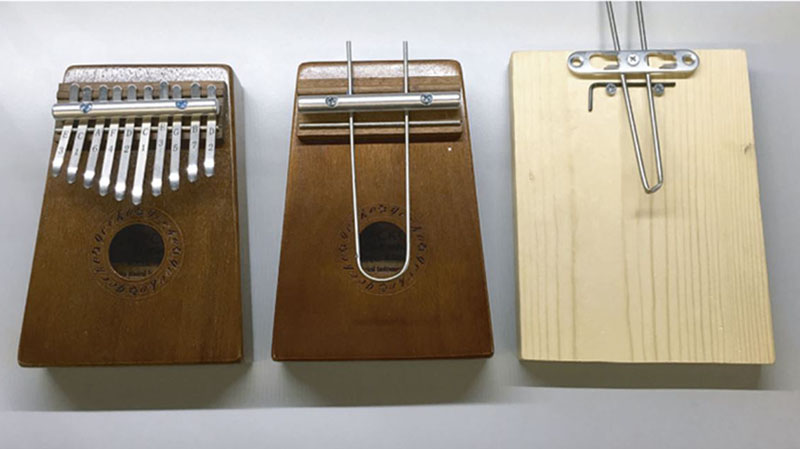We’ve covered construction of novel music instruments on these pages, and we’ve covered many people tearing down scientific instruments. But today we’ve got something that managed to cross over from one world of “instrument” into another: a music instrument modified to measure a liquid’s density by listening to changes in its pitch.
This exploration started with a mbira, a mechanically simple music instrument. Its row of rigid metal tines was replaced with a single small diameter hollow metal tube. Filling the tube with different liquids would result in different sounds. Those sounds are captured by a cell phone and processed by an algorithm to calculate the difference in relative density of those liquids. Once the procedure was worked out, the concept was verified to work on a super simple instrument built out of everyday parts: a tube mounted on a piece of wood.
At this point we have something that would be a great science class demonstration, but the authors went a step further and described how this cheap sensor can be used to solve an actual problem: detecting counterfeit pharmaceuticals. Changing composition of a drug would also change its density, so a cheap way to compare densities between a questionable sample against a known good reference could be a valuable tool in parts of the world where chemistry labs are scarce.
For future development, this team invites the world to join them applying the same basic idea in other ways, making precise measurements for almost no cost. “Any physical, chemical, or biological phenomena that reproducibly alters the pitch-determining properties of a musical instrument could in principle be measured by the instrument.” We are the ideal demographic to devise new variations on this theme. Let us know what you come up with!
If you need to do quick tests before writing analysis software, audio frequency can be measured using the Google Science Journal app. We’ve seen several hacks turning a cell phone’s camera into instruments like a spectrometer or microscope, but hacks using a phone’s microphone is less common and ripe for exploration. And anyone who manages to make cool measurements while simultaneously making cool music will instantly become a serious contender in our Hackaday Prize music instrument challenge!
[via Science News]
















would it depend on the mobile phone what sound quality you would gather, some older phones had great mics but most of them where pretty crap until recently.
It’s seeming like a go/no-go test, where all you want is to see if one thing is the same as the other, in which case, I don’t think mic quality really counts for much.
Not really, assuming an initial timebase calibration it’s hard (probably impossible?) for a mic to change the pitch of a note, only the transfer function. So even a poor quality mic (heck, even a mic run through a comparator) will still provide a good signal for pitch measurement.
A cell phone mic has probably a low-cut filter for better voice sound, there’s a lot of ‘garbage’ in the lows. This can help too.
And like others said, it’s comparing, so in theory every mic is suited.
I wonder if you tuned the tube to resonate at a frequency, then used a speaker connected to the cell phone to vibrate that tube and had a piezo connected to the holder to pick up the vibrations and stepped the frequency of the speaker up and down until you got the peak on the piezo would that not provide a much better way of comparing samples.
Piezo microphones are probably not sensitive enough.
That is how commercial liquid density meters work.
Couldn’t you eliminate the cell phone by having a pair of tubes, to analyze both samples at once?
A density mismatch should cause an audible beat frequency, yes?
Commercial versions of this device have a reference oscillator, which is basically a solid tube with a known mass and size, and they compare the difference in frequencies to eliminate the effects of air pressure and temperature that would otherwise de-tune the system.
It’s much like Archimedes ‘eureka’ moment, a simple way of determining relative densities.
https://en.wikipedia.org/wiki/Oscillating_U-tube#/media/File:U-Tube.jpg
https://upload.wikimedia.org/wikipedia/commons/thumb/f/f9/U-Tube.jpg/588px-U-Tube.jpg
The article and their paper read as if they invented a new device, but all they’re doing is making a well known mass flow meter, cheaply. That’s a cool real hack, but not the same as what’s implied.